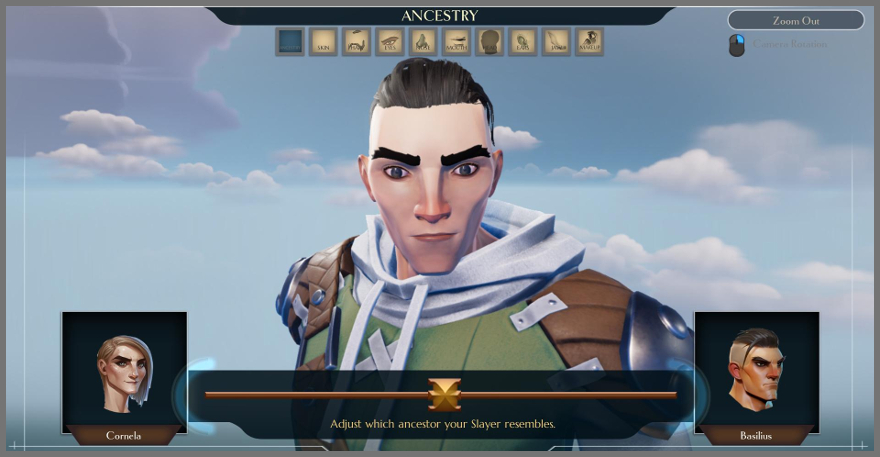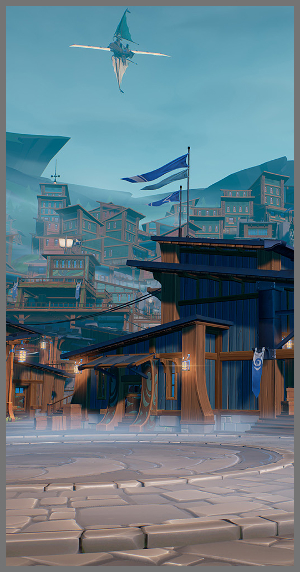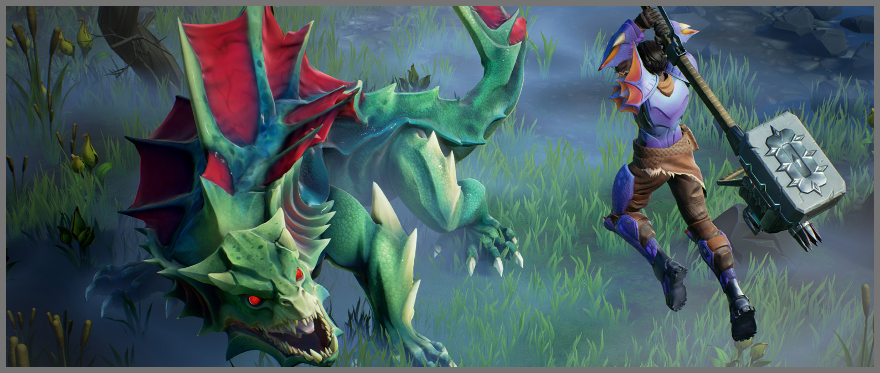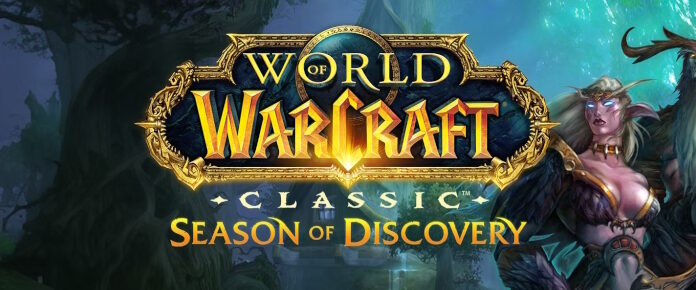
The end of September marked a major milestone for Dauntless, the upcoming monster-slaying action-MMORPG from indie developer Phoenix Labs, as it officially concluded its Founder’s Alpha event and made the jump into closed beta. Since then, legions of would-be Slayers have stormed the Shattered Isles, taking up arms to defend the last bastions of human civilization from destruction at the hands (and talons, fangs, or similarly sinister appendages) of the marauding monstrous beasts known as Behemoths.
And as it so happens, I was one of them. As a long-time fan of Capcom’s venerable Monster Hunter series, which pioneered the “kill-carve-and-craft” action-RPG subgenre upon which Dauntless aims to build, I’ve been eager to check it out for some time now. So when closed beta rolled around, I shelled out for a Founder’s Pack and joined my fellow prospects in the frontier settlement of Ramsgate, where I hoped to prove worthy of the Slayer mantle, or failing that, then at least to avoid dying horribly.
There’s a lot to talk about in Dauntless, so I want to jump right into it, but if you’re not familiar with the game, the premise is simple: You’re a Slayer. You slay things – giant monsters called Behemoths, to be exact. When you slay things, you cut them up for parts, which you can then use to craft or upgrade your gear, so then you can go kill bigger, meaner things and cut them up for parts and… you get the idea.
But before you can start slaying huge beasts and turning them into gloves and stuff, you have to create your character, which in Dauntless is something of a two-step process. The first thing you do is select two “ancestor” characters from a roster of 12 candidates and adjust a slider to determine which your character favors more. This isn’t the first time I’ve seen a system like this, but I feel like it’s one of those things that’s interesting in theory but ends up just being tedious.
That’s a shame because after you finally give up on experimenting with different ancestor combinations and just pick something, you’re presented with a much more traditional – and intuitive – customization menu. This is where you can select your character’s hairstyle and other physical features such as hairstyle and eye color and, moreover, try to offset the clumsiness of the ancestor system with a number of sliders that let you fine-tune your character’s facial structure.

Although the library of customization options is noticeably wanting in some categories, such as tattoos and facial hair, I can only assume that the selection will expand between now and launch. Other than that, the character creation is solid enough—for now, anyway. My only major criticism is that, thanks at least in part to the lack of any sort of physique-customization options, it’s difficult to make a character that doesn’t land somewhere between Ziggy-Stardust-era David Bowie and Tilda Swinton as Orlando on the androgyny scale. The end result, unfortunately, is that every character—male, female, or otherwise—winds up looking rather same-ish.
After character creation, you’re promptly dropped from an airship onto a floating sky-island, population: one (1) greenhorn Slayer with only a borrowed weapon and a dream and one (1) increasingly angry Rogue Gnasher, a Behemoth I can only describe as a dino-beaver (beaver-saur?) with an armor-plated tail and a hell of an overbite. At present, Dauntless offers little in the way of tutorial except for a handy reference sheet of the basic controls and a brief overview of your equipped weapon’s playstyle.
Thankfully, the controls are fairly intuitive – although admittedly somewhat more so on an Xbox controller, which I opted to use most of the time, than on mouse-and-keyboard. Both seemed perfectly viable to me, but for action-heavy games like Dauntless, I tend to opt for a controller as a matter of personal preference.
Whichever you prefer, the controls are fairly straightforward, and there aren’t too many buttons to memorize. You can run, sprint, jump, dodge, and of course attack; each weapon has a primary and a secondary attack (which can be linked to perform combos) and a special ability. You’ve also got four consumable slots, plus a flare gun you can fire off to signal your position to teammates. Anyone who’s played a hack-and-slash action game in the past decade or so should be familiar with the controls almost right away, and those who are wholly unfamiliar can probably get the hang of it in a few minutes.
This is good because you have to get the hang of it real quick unless you want to end up beaver chow. Although the introductory hunt’s difficulty is scaled back considerably from that of the hunts you’ll be going on later in the game, it serves not only to allow players to familiarize themselves with the controls, but also to get acclimated to the flow of combat.

Combat in Dauntless hinges on the management of two resources: health and stamina. Health is exactly what you’d imagine: You run out, you go down. Downed players can be revived, but each time a player falls, it increases the risk meter. If the risk meter fills, the hunt is a wash and the Slayers are emergency evac’d to safety.
To avoid such a shameful fate, Slayers have to carefully manage their stamina, which is required to perform a number of combat actions such as dodging or using certain attacks. Stamina regenerates steadily over time, but if you exhaust your reserves completely, it’ll take a moment to begin regenerating again, leaving you wide open to punishment from a vengeful Behemoth. Dauntless does subscribe somewhat to the fair-but-punishing, hard-but-rewarding school of combat in the same vein as the Monster Hunter and Souls series, albeit not to the same extreme. Make no mistake: Skill matters in Dauntless; being able to read and react to the enemy is crucial, and mistakes are often soundly punished, but all-in-all it feels a bit faster-paced than MH or Souls and certainly more forgiving.
 The flow of battle moves smoothly in Dauntless, as Slayers deftly dodge incoming attacks, searching for an opening to attack before they’re put back on the defensive. I feel like it hits a happy medium between the slow, deliberate, one-misstep-and-you’re-toast showdowns typical of Monster Hunter and the full-on breakneck pace of, say, Gods Eater or Bayonetta. The controls feel crisp and responsive, and I’ve had surprisingly few latency issues, and none severe enough to be worth recalling. It’s not perfect, mind you; combo timing can be finicky at times, and sometimes physics interactions – especially between players and Behemoths – don’t always resolve in the ways you’d expect, but these issues have become fewer and farther between with each patch to the point that they’re basically negligible.
The flow of battle moves smoothly in Dauntless, as Slayers deftly dodge incoming attacks, searching for an opening to attack before they’re put back on the defensive. I feel like it hits a happy medium between the slow, deliberate, one-misstep-and-you’re-toast showdowns typical of Monster Hunter and the full-on breakneck pace of, say, Gods Eater or Bayonetta. The controls feel crisp and responsive, and I’ve had surprisingly few latency issues, and none severe enough to be worth recalling. It’s not perfect, mind you; combo timing can be finicky at times, and sometimes physics interactions – especially between players and Behemoths – don’t always resolve in the ways you’d expect, but these issues have become fewer and farther between with each patch to the point that they’re basically negligible.
When the dust settles and the Behemoth has (hopefully) been vanquished, all that’s left is to reap the spoils of victory. The post-hunt screen assigns you a rating, both individually and as a group, based on your performance – though I don’t think it has any further gameplay effect – and you’re rewarded with crafting materials based on any Behemoth parts you broke during the fight: severed tails, broken tusks, that sort of thing, as well as a monster core, which is like a little gacha capsule full of additional monster bits, that you can open up once you get back to town. It’s worth noting that the core system is being reworked so that players will instead carve parts directly from the Behemoth after a hunt, but as of the time of writing, that’s yet to be implemented.
After the hunt, you hop an airship back to Ramsgate, which serves both as your base of operations between hunts and as the game’s social hub, where players can look for groups, form and join guilds, or just sit and have a chat. In Ramsgate, players can talk to NPCs to pick up quests—almost all of which require you go to hunt some Behemoth or another—which, upon completion, can unlock new Behemoths to hunt, new gear to craft, and of course more quests to complete.

Quests provide the structure to guide players through the game, but that’s not to say that quests are the primary motivation to keep playing. The real draw is the variety of gear that you can craft to allow you to pursue more dangerous quarry. A Slayer’s loadout consists of a weapon, armor (head, chest, arms, and legs), consumables, and a magical lantern. We’ll get to that in a minute.
Slayers can choose from one of four different weapon types: sword, axe, hammer, and chain-blades (with a fifth, the War Pike, coming in the future). I don’t have the space to go over each one in-depth, but here’s a rundown: Swords are well-balanced weapons whose solid power and good mobility make them perfect for beginners yet deadly in the hands of a veteran. Axes fill the slow powerhouse niche, allowing their wielders to charge attacks to unleash devastating blows. Hammers are odd, in that they incorporate explosive shells that can be fired at an enemy or used as a rocket-boost to propel users forward, but they’re still—you know, hammers. Lastly, the highly mobile chain-blades are exactly what they sound like: two blades attached by a chain, which allows for lightning-fast combos at both close- and long-range.
Each type of weapon has its own specific attack combos and special abilities, but I honestly don’t feel like any of them offer a whole lot in the way of depth at this point in development. Once you’ve memorized your handful of combos and learned how to use your special ability, that’s all there is to it. I expect this issue will be at least somewhat alleviated by the introduction of additional attack types, such as draw-attacks or aerial attacks, but as it stands, the movesets are just too limited to allow for the kind of flexibility and depth that makes a weapon engaging to use and satisfying to master.
Perhaps the single-most playstyle-defining decision Slayers will make is which armor to wear. In addition to its obvious use – i.e., putting hard bits in front of your soft bits – armor can also provide skills that can enhance a Slayer’s abilities in a variety of ways. The armor-skill system in Dauntless will be immediately familiar to Monster Hunter players, but to those who have never encountered something like it might find it a bit obtuse, especially given the lack of in-game explanation on the matter.
Here’s how it works: Each piece of armor can have one or more armor skills (known in Dauntless as “Aspects”) attached to it, which is represented by the skill’s name followed by a number in parentheses, e.g., “Endurance (1),” which indicates that the associated armor piece provides one level of the Endurance skill when worn. However, most skills have a certain “activation threshold,” meaning that the skill does not activate until it hits a certain level (cumulative across all equipped armor pieces). The Endurance skill has an activation threshold of level 2, meaning that piece of gear with Endurance (1) isn’t going to do anything on its own.
However, if you were to equip a second piece of gear that also had the Endurance (1) armor skill, you would be granted the effect of Endurance (2), which increases your max stamina by 15%. Many skills can then be raised even further by adding additional armor pieces with the appropriate skills. Add a third piece of armor with Endurance (1), and now you’ve got Endurance (3), which, in addition to the effect of Endurance (2), also provides a 15% increase to your stamina regeneration rate. Mixing and matching armor pieces to get that perfect mix of skills for your playstyle is perhaps the single biggest motivator in Dauntless, and even with the somewhat scanty number of skills currently available (17 according to the wiki), there are nevertheless a staggering number of armor skill combinations with which to tailor your Slayer’s playstyle to your liking.

No Slayer’s toolkit is complete without some useful consumable items, and you’ll be responsible for crafting those, too, using herbs, ore, and other resources that can be gathered in the field during hunts. Consumables are divided into four categories, and Slayers can take one type of item from each category on any given hunt (though the exact number you can carry depends on the specific item in question). The four consumable categories are healing, offense, defense, and air support. The first three are pretty self-explanatory; healing consumables restore your health, offense consumables boost your attack capabilities in some manner, and defense consumables provide buffs to you and/or your teammates. Air support, too, is pretty much what it sounds like: it’s a consumable item that allows you to call in an airship to provide assistance, usually in the form of an airdrop that provides useful items (and not, unfortunately, in the form of carpet-bombings or orbital strikes). Consumables aren’t going to make or break your entire playstyle like weapons and armor do, but bringing the right tools for a given hunt can make things a whole lot easier for you and yours.
Lastly, there are lanterns, which you can think of as reusable consumables of a sort. Each lantern provides a special ability that can be activated at any time, though the lantern must recharge between uses. The effects provided by lantern abilities are useful, such as an AoE healing aura or a buff that grants a damage shield to your entire group. They’re a nice touch, providing an additional way for players to tweak their Slayers’ playstyles, but the range of possible skills is too limited at present (four, as of this writing) for lanterns to feel like a particularly meaningful part of the loadout.
Once you’ve taken care of your preparations in Ramsgate, the only thing left to do is make your way to the hunt board to venture out in pursuit of another Behemoth. Hunts can be undertaken solo, with a premade group, or with a matchmade group, whichever suits your fancy. From there, the cycle repeats itself: Hunt Behemoths, craft gear, complete quests, unlock new Behemoths to hunt, and so on.
It’s an unapologetic grind, and one with which Monster Hunter veterans will be intimately familiar, but make no mistake: Dauntless provides an experience quite distinct from its forebear, with less emphasis on careful, painstaking preparation and tense, deliberate hunts and more focus on fast-paced hack-and-slash combat in shorter, easily digestible hunts. It’s not for everyone, of course, but if you’re a fan of the genre, it’s worth keeping an eye on Dauntless as it makes its way to launch.















